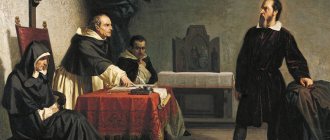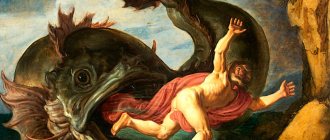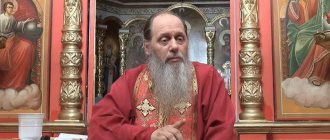Theology - a brief history of science
Theology or theology, from the Greek words theos
- what does
God
, and logos -
teaching
.
Justifies the doctrine of God
, his actions in the world, his revelations.
In Christianity, theology is accepted as the doctrine of the Triune God in Himself, or the doctrine of God’s actions in relation to the world and man. Knowledge of God is possible only through prayer, worship and reasoning about him. The primary sources of Christian theology were the Bible and ancient philosophy (the teachings of Plato and Aristotle, and their disciples). In the history of theology there are periods
:
- patristics
I-VIII century in the East, and until the VI century in the West, - scholasticism
: early period VII-XII century, mature XIII century, and late until the XVI century, - theology of modern and contemporary times
- XVII-XXI centuries.
The formation of theology as a science occurred in the early stages of the development
of Christianity,
up to the 3rd-4th centuries inclusive.
At this time, the ancient civilization was decomposing and a new religion was being formed.
The science of theology began with poetic works written by the ancient Greek poets Orpheus, Homer, and Hesiod about the gods.
Later, historians who interpreted ancient myths about the gods: Pherecydes of Syros and Euhemerus of Crete were also classified as theologians. Theologians and philosophers Quintus Septimius Tertullian and Adamant Origen considered theology to be an appeal to pagan cultures. And the term “theology”
came into use already
in the 5th century
, thanks to St. Augustine.
Patristics
Period beginning in the 2nd century
, can be literally translated as the teachings of early Christian thinkers, and the time of defense of the basic principles of Christianity.
It was necessary to prove the superiority of Christianity over other religions. This period is also divided into Latin and Greek.
In some faiths
they are called Eastern and Western. Eastern
Greek patristics are based
on Plato's teachings on the divine
. Outstanding representatives of Greek patristics are the Cappadocians Saint Basil, Bishop of Caesarea the Great, Saint Gregory the Theologian and Saint Gregory of Nyssa. All of them adhered to the idea of unifying faith and knowledge.
Latin Western
patristics is based on Roman traditions that showed interest in man,
based on the philosophy of Aristotle
. An outstanding representative of this period was Blessed Aurelius Augustine. He does not separate philosophy and theology. He defends Christianity and refutes paganism. Expresses the idea of God’s involvement in everything that happens in reality.
In the IV-V centuries
, there is
a systematization of religious teachings
and the formation of classical theological systems, based on the biblical worldview and philosophical thought of people who tried to know the divine.
Theology acquires
not only ideological
content, but also political content
.
Scholasticism
Early period
follows the patristic period and dates back to
the 8th-11th
centuries.
Characterized by a higher level of knowledge systematization. An outstanding representative of the period of early scholasticism is John of Damascus, who wrote the works “Philosophical Chapters” and “About a Hundred Heresies in Brief.” Systematized all early research. During the period of scholasticism, knowledge more abstract from reality appeared, based on reasoning and inference. Scientific knowledge developed: philosophy and logic
. The strongest manifestations of scholasticism were noted in Western Europe.
The period of developed scholasticism dates back to the 13th century.
.
The most important theologian of the mature period was Thomas of Aquitaine, who wrote the fundamental work “Summa Theologica”. Scholasticism becomes the most authoritative direction in theology. The Church monopolizes education in its hands. Education
in schools is entirely
theological in orientation.
Only representatives of the clergy could engage in science.
At the same time, the church carried out large-scale campaigns to exterminate non-believers. To strengthen its power, the church creates an inquisition that
tortures and burns all dissenters.
Late scholasticism of the XIV - XV centuries
characterized
by attempts to introduce
knowledge of non-Christian origin
into theological scholastic teachings . But the church remained unchanged and authoritative. Until the end of the 16th century, theology occupied a leading position.
New period
In theology it is associated with the historical Counter-Reformation, the creation of new
religious teachings
.
Theology again becomes apologetic, it needs to defend its teachings from freethinking and atheism
. A theology based on the philosophy of modern times appears.
Theology in Russia
The doctrine of God appeared
in Russian territories simultaneously with
the advent of Christianity
. Periods of development differ from the global ones. But, they correspond to the periods of historical development of the state:
- pre-Mongol and post-Mongol periods
, the time of developing one’s own theological teachings, - the period of unification of Russian principalities and centralization of power,
the beginning of relations with Western states, where the heyday of theology was observed, - Russian Baroque
period , when the role of the Kiev-Mohyla Theological Academy and theological circles close to it intensified, - the period after the reign of Emperor Peter I
, and strengthened relations with the West, - consideration of projects for the creation of Russian theology
in the 18th-19th centuries, - the period of the Silver Age, with an attempt to restore the connection between church
and
society, - the period after the October Socialist Revolution and the new period
of the late 20th and early 21st centuries.
In the 20th century, a movement of adherents of imyaslaviya (worshipers of the name of God) spread in Russia. The Church itself affirms the need for theological control over systematic dogma.
Historical reference
The term “theology” first came into use in ancient Greece, where it was applied to the systematic presentation of myths and especially the genealogies of pagan gods, most often carried out in poetic form. form. Such “theology” not only did not have the character of obligations. creed, but could also be generally irreligious: Cicero calls “theologians” the free-thinking followers of the philosopher Euhemerus of Crete, who taught that gods are just deified people. A more definite connection with religion. faith is established where the word “theology” is applied to mystical. tradition of secret religions. circles - tias (for example, in the language of late antique religious philosophers, the word “Theologian”, used as a proper name, is a designation for the legendary ancient poet Orpheus, who founded the Orphic community). Often priests were called “theologians,” whose duty was to tell local myths to temple visitors. However, in all cases the term “theology” referred to the sphere of mythology, and not philosophy. speculation. Aristotle, relying on the criticism that Plato subjected to the “theology” of folk and poetic. myths, for the first time transferred the designation “theology” to speculation. "first philosophy", "highest contemplative science". For Aristotle, theology is, first of all, the doctrine of the immovable prime mover, the source and goal of world existence, and it was Aristotle’s usage of words that had a decisive influence on the further history of the word. However, for Tertullian and Augustine, “theology” is pagan false teachings about the gods; for Dionysius the Areopagite and the tradition generated by him, it is not rationalistic. analysis of Revelation, but Revelation itself, that is, the doctrine of the Bible (this is how Bonaventure used the word theologia). For Augustine or Anselm of Canterbury religions. and philosopher contemplation of the Divine coincide in a single act of intuition, and therefore every speculative doctrine of faith is precisely “philosophy”, and not k.-l. a special form of knowledge. The situation changes in mature scholasticism, which conceptualizes theology as a discipline independent of philosophy. Thomas Aquinas also prefers to use synonyms. with the phrase “sacred teaching” (sacra doctrina), finally, in Henry of Ghent this term is finally consolidated in modern times. sense.
Philosophical structure of Christian theology
B.'s idea is, in principle, bipolar, because it presupposes both superrational revelation and rationalism. analysis of this revelation. This is already expressed in the term “B.”, the first element of which, according to P. Tillich, “is Theos, God, communicating something about himself, the element of Revelation; the second element is logos, the rational word of what God communicates in his message.” At the same time, the logos - the system thinks. Greek techniques philosophy (in both Byzantine and Latin Byzantium, during its heyday, there was competition between Platonism and Aristotelianism, rethought in Neoplatonism). For this reason, B. most often has a sort of two-tier structure: the lower tier is the philos. speculation about the absolute as the essence, root cause and purpose of all things (i.e. exactly what Aristotle called “theology”), the upper tier - the “truths of Revelation” that cannot be discerned by reason, directly communicated in the “Word of God”. Hugo of Saint-Victor distinguished between “secular B.” (theologia mundana), i.e. the highest of speculative philosophies. disciplines, and “divine B.” (theologia divina), taught by God in the incarnation of the Logos (God-man) and in the church. sacraments. In scholasticism, these two types of philosophy received the stable designation “natural theology” (theologia naturalis) and “revealed theology” (theologia revelata), and the relationship between these two types of philosophy was interpreted by Zap. church in the context of the antinomy of “nature” and “grace”. Shifting the emphasis to mystical-ascetic. the experience captured in Tradition determines the appearance of Orthodox theology.
The God that theism presupposes. religion is, first of all, the personal Self, the “living God” of the Bible: therefore, the activity of B. is thought of simultaneously as both intellectual theorizing and as “seeking the face of God” (Ps. 23:6) - personal contact with God. The impersonal spiritual essence can be contemplated without fear, but the personal God himself “looks” at the contemplator, and the theological. the mind invariably feels this searching gaze on itself. This is the unfreedom of the theologian. The unforced, almost playful mood of pagan speculation becomes unthinkable for B.: any miscalculation in relations with the personal, willing, loving and angry absolute is dangerous; hence the inevitable concept of heresy and “unbelief” for B. He who has fallen into heresy does not think abstractly. a mistake, but a personal transgression, endless in its consequences, in one’s relationship with God the absolute, as if cosmic. “tactlessness”, cutting off the connection between the “mountain” and the “down”. After all, faith in God is conceived at the same time as faith in God - not just conviction in his existence and in the truth of his “word,” but an act of trust in the speaker himself. Hand in hand with trust in God goes an equally personalistically understood trust in people - the bearers of tradition, in “God-bearing” authorities, in the “elders”, who together constitute the “Church of Saints”. B. is impossible outside of social organization - the concept of the “Word of God” loses its meaning without the concept of the “people of God” as the addressee of the “word”. This is expressed in the words of Augustine: “I would not have believed the Gospel if I had not been prompted to do so by the authority of the universal Church.” The attempt of the Protestant churches to separate the authority of the Bible from the authority of the Church could not completely deprive B. of its institutional character as a doctrine addressed from those who were “set” in the Church to teach its members.
B. as a rationalist. discipline must again and again put itself under suspicion, and, moreover, with orthodox-theistic. point of view: the “cold”, impersonally aloof approach to the “mystery” required by the very nature of reason is specific. the atmosphere is logical. consideration and debate, i.e. everything that is included in the concept of scholasticism, is necessary for the impersonal functioning of theism. religion, but may offend the personal feelings of the believer. “It is absurd to argue about the Trinity at crossroads and turn the pre-eternal birth of the Son into a subject of temptation and into a field of public competition!” - these words of Peter of Blois (d. 1200) express the mystic’s anxiety for the intimate experience of the “mystery,” alienated and profaned even in the most orthodox logicalization of faith.
Int. The duality of B.’s idea is also felt in the idea that true authority here has the right to be possessed not just by a professionally erudite, but at the same time, first of all, by a “perfect”, “God-wise” person, whose personal holiness allows us to conclude about personal penetration into the “secret” » God. Thus, the ideal of the theologian oscillates between two completely dissimilar ideals: the ideal of the scientist who works with logical compulsion. syllogisms, and the ideal of the “friend of God”, to whom God is revealed in a personal and therefore “ineffable” experience of communication. The relationships between these two poles provide a large number of typologies. options, alternately dominant in different. era of development of B. One of the key points of the theological method of St. fathers became apophase. The apophatic method proceeds, on an epistemological level, from the empirically acquired conviction that God cannot and should not be a “subject” of intellectual analysis and knowledge, like the objects and objects of the created world. The incomprehensibility of God and the methodological incompleteness, imperfection, and inability of human thought to embrace God are affirmed. Theological apophatism, despite its similarities with philosophical apophatism, has completely different roots. Just like the main intuition Greek ancient philosophy thought was the intuition of a harmonious cosmos - a cosmos that is reasonable in its foundations and therefore “speculative” - the most important intuition of patristic thought was the opposition of God and the world. This opposition does not mean a break between God and the world - on the contrary, the most important category of B. becomes hearing the Word of God, fulfilling His good will, expressed in the Word. Patristic apophatism, on the ontological level, does not allow concepts that logically connect the existence of God and the world. B. learned to function in extremely difficult methodological conditions. conditions: on the one hand, apophase - we almost cannot talk about God, on the other hand, it is absolutely necessary. This determines the specificity of theological thought, where it is forced to talk about what cannot be talked about, expresses the inexpressible, talks about completeness from a situation of incompleteness. For this reason, theological language is figurative rather than conceptual. Metaphorical philosophy. concepts used by B. is explained by the fact that, created by philosophy on the basis of the generalized experience of perception of this world, they, when applied to the sphere of uncreated being, inevitably turn into philosophy. metaphors. Extracted from the original sphere of their philosophy. conversions for use in theology, they are freed from philosophy. connotations, “deconceptualized” (in the terminology of V. N. Lossky).
“Deconceptualization” in the theological discourse of philosophy. concepts, apophase, concluded both at the epistemological and ontological levels of theological discourse, can naturally lead to an understanding of the futility and even uselessness of the discourse itself, the futility of the knowledge of God. Realizing this possibility, St. Gregory the Theologian wrote: “I call incomprehensible not that God exists, but that He is (...) There is a very big difference between being sure of the existence of something and knowing what it is” [St. Gregory the Theologian. Homily 28 (on theology 2nd), 6]. The most important principle for patristic theology is the distinction in thinking about God between His essence and energies (actions). The essence of God is absolutely incomprehensible, incommunicable and incommunicable to created beings. However, being completely “other” in relation to the world, God manifests Himself in the world. This way of His manifestation in the world of St. Fathers describe it using the concept of “energy”. Thus, the basis of theological cataphatics is the principle: God is incomprehensible in essence, but knowable in his energies in the world.
Main directions of development of Christian theology
By 2nd century the Christian Church, in the fight against Montanism, comes to a conscious view of the era of the “apostolic men” as a completed era; At the same time, Judaism, which survived the collapse of the Jerusalem theocracy in 70, sees its only chance in “erecting a fence around the Law,” that is, in canonizing and commenting on the text of the Torah. Thus, a prerequisite for exegetical work is created. work on the closed “Scripture”, that is, for B. Moreover, the necessary freedom for contemplation. understanding of Scripture is created through allegorical. interpretation of the latter (exegesis of the Alexandrian school). Christian B., originally developing in Greco-Roman ethnicity. and linguistic environment, assimilates antiquity. models of philosophy speculation, which allowed him to develop in Trinitarian and Christological. disputes of the 4th–7th centuries. such a developed system is conceivable. dogmatics, which neither Judaism nor Islam knew (in the latter, religion is not completely separated from sacred law and therefore is focused not on the interpretation of the universe, but on human behavior). This is the work of the Christian Church on dogma, at the center of which is the problem of the relationship between the personally understood absolute and the empirical. peace, basically ends by the 8th century. A broad systematization of the available “tradition” based on Aristotelian logic. schemes were first carried out by John of Damascus.
In the 11th century in the West, a new rise of Christian philosophy begins, no longer occupied with the creation of dogmas, but with their explanation (Anselm of Canterbury). In the 12th century into the horizons of the West. Christian B. (scholasticism) thanks to numerous. translations include works of Hebrew. and Islamic theologians, as well as John of Damascus. Mystic. B.'s direction, based on the data of “internal experience” and distrustful of logical. calculations, tries to resist scholasticism (Bernard of Clairvaux against Abelard), but in the West is forced to bow to the latter - and only in the Orthodox East, since the time of Symeon the New Theologian, does he prove to be the master of the situation (the concept of B. as “smart doing”; the systematization of mystical B., hesychasm , undertaken by Gregory Palamas). Within the intellectual world of scholasticism, an international and even (to a certain extent) interfaith Judeo-Christian-Islamic community is being created: in the very centuries when in Spain the conflict between Christianity and Islam was decided by the sword, the Muslim al-Ghazali and the Jew Ibn Gebirol served for the West. B. school authorities. This era was received by B. in the 13th century. its completion in the teaching of Thomas Aquinas.
In subsequent centuries, Christian B. works on consistency. destruction of the scholastic edifice (I. Duns Scotus, W. Ockham): the synthesis of the New Testament and Aristotle, achieved by previous generations, did not satisfy either those who stood on the side of worldly tendencies in humanism, or those who tried in new conditions to revive a serious attitude towards principle of faith. The Averroist theory of dual truth, which came from the philosophy of Islam and was rejected by Thomas Aquinas in the name of unconditional harmony between logic and faith, acquired more and more obvious and hidden supporters. M. Luther resolutely rejected the very idea of B. as he thought. disciplines: the subject of B. is for him exclusively the personal relationship of a person in need of God and a person calling out to God; the latter is elusive for abstract constructions and is revealed only in the concrete, extra-logical. the event of Christ's death on the cross (the so-called B. cross). However, later F. Melanchthon returns to Aristotelian-scholasticism. heritage, formal thinks. the schemes of which are accepted equally dogmatically. B. Counter-Reformation (F. Suarez, R. Bellarmine) and Protestantism, until the 18th century. do not become common currency in Catholic, Protestant and Orthodox school dogmas. F. Schleiermacher tries to adapt B. to the requirements of modern European culture, adopting for him the style of the Enlightenment worldview. On the contrary, S. Kierkegaard, comprehending the crisis of this culture, seeks a way out in the belated implementation of Luther's covenant - in a return to biblical faith, breaking the unnatural union with the Greek. rationalism and realizing itself as pure proclamation. Kierkegaard's ideas were developed in the 20th century. in dialectical theology; adjacent to it is the movement for the demythologization of faith, initiated by the theory of R. Bultmann.
Theological disciplines
The most important sections of Christian theology are: 1) the study and interpretation of Holy Scripture; 2) study, interpretation, apology and systematic. presentation of church doctrine and morals (dogmatic, basic, moral theology, patrolology); 3) study of the history of the Christian church and others. aspects of her life; 4) study of the internal aspects of church life - worship, structure, discipline (liturgics, canon law, asceticism, pastoral theology). All these disciplines are characterized by close interaction with each other and with others. humanitarian disciplines, application of modern scientific methods while simultaneously adhering to the most important tenets of church doctrine.
Some specialization of theological disciplines has long existed in Christian theology. It was mainly related to the needs of theological education and catechesis. Thus, in the Alexandrian school in the 3rd century. the first experience of thematic teaching of B. was created. It practiced four successive stages of theological disciplines - something that corresponds to the apology of Christian teaching and life, Christian ethics, dogmatics and biblical studies. It was assumed that these stages of studying theological disciplines correspond to the ascent through the stages of Christian knowledge of truth.
In the West, the formation of the structure of theological disciplines occurs in the post-Reformation period. On the one hand, this was due to the development of Catholicism. theological school in connection with the tasks of the Counter-Reformation. On the other hand, a characteristic feature of the New Age is the formation of science, with increasing specialization in it. They begin to clearly distinguish between “positive” and “speculative” B. The first includes the study of Revelation and the experience of its historical assimilation, the second - the orderly study and presentation of the truths of faith and the norms of life in accordance with it. Thus, biblical studies, church history, patrolology, dogmatic and moral theology, and apologetics are distinguished. Practical theological disciplines are gradually taking shape. G. Callixtus (1586–1656), a follower of F. Melanchthon, in his “Notes of Moral Theology” (1634) distinguishes theologia dogmatica as a study of the tenets of doctrine and theologia moralis as a study of Christian morality. Jesuit Dionysius Petavius (1583–1652), author of op. “On Theological Dogmas” (1644–50), systematizes dogmas as the subject of dogmatic philosophy. The main result of his classification work is the separation of systematic theology from historical, and within the framework of systematic theology, the distinction between dogmatic and moral philosophy. The tasks of inter-confessional polemics necessitated the creation of a “accusatory » B. The most famous theologian who worked in this area was R. Bellarmine.
In the tradition of Rus. church, enshrined in the works of Metropolitan. Athanasius (Bulgakov), all theological disciplines are divided into main and corresponding auxiliary disciplines (shown in parentheses). The main disciplines include hermeneutics (introduction to the books of Holy Scripture), exegesis (biblical archaeology), patristics (patrology), symbolism (history of the Creeds), dogmatic theology (history of dogma, comparative dogma), moral theology, liturgics (church archeology, comparative liturgics), canon law (legal history, comparative law). A special group consists of applied theological disciplines: pastoral theology, homiletics (history of eloquence) and asceticism (history of asceticism).










